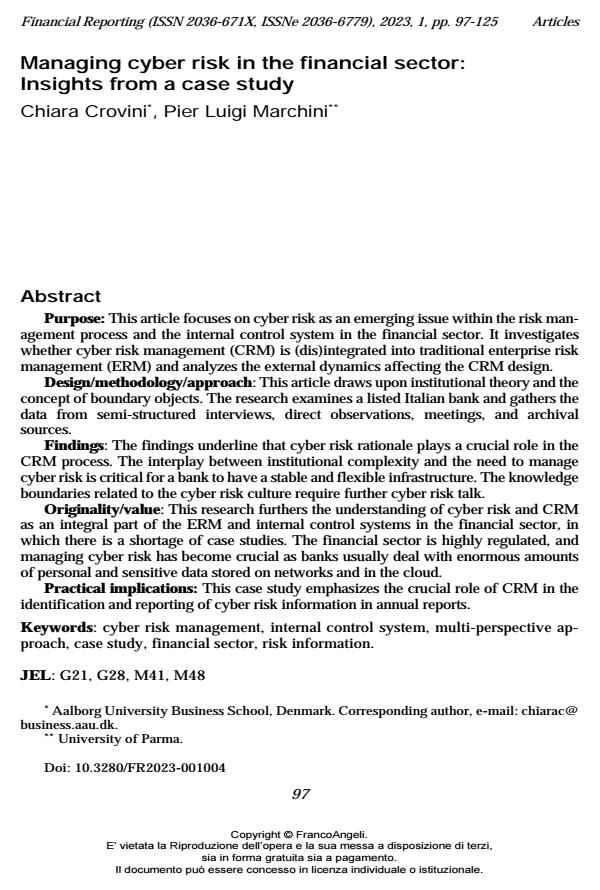Managing cyber risk in the financial sector: Insights from a case study
Titolo Rivista FINANCIAL REPORTING
Autori/Curatori Chiara Crovini, Pier Luigi Marchini
Anno di pubblicazione 2023 Fascicolo 2023/1
Lingua Inglese Numero pagine 29 P. 97-125 Dimensione file 201 KB
DOI 10.3280/FR2023-001004
Il DOI è il codice a barre della proprietà intellettuale: per saperne di più
clicca qui
Qui sotto puoi vedere in anteprima la prima pagina di questo articolo.
Se questo articolo ti interessa, lo puoi acquistare (e scaricare in formato pdf) seguendo le facili indicazioni per acquistare il download credit. Acquista Download Credits per scaricare questo Articolo in formato PDF

FrancoAngeli è membro della Publishers International Linking Association, Inc (PILA)associazione indipendente e non profit per facilitare (attraverso i servizi tecnologici implementati da CrossRef.org) l’accesso degli studiosi ai contenuti digitali nelle pubblicazioni professionali e scientifiche
Purpose: This article focuses on cyber risk as an emerging issue within the risk management process and the internal control system in the financial sector. It in-vestigates whether cyber risk management (CRM) is (dis)integrated into traditional enterprise risk management (ERM) and analyzes the external dynamics affecting the CRM design. Design/methodology/approach: This article draws upon institutional theory and the concept of boundary objects. The research examines a listed Italian bank and gathers the data from semi-structured interviews, direct observations, meet-ings, and archival sources. Findings: The findings underline that cyber risk rationale plays a crucial role in the CRM process. The interplay between institutional complexity and the need to manage cyber risk is critical for a bank to have a stable and flexible infrastructure. The knowledge boundaries related to the cyber risk culture require further cyber risk talk. Originality/value: This research furthers the understanding of cyber risk and CRM as an integral part of the ERM and internal control systems in the financial sector, in which there is a shortage of case studies. The financial sector is highly regulated, and managing cyber risk has become crucial as banks usually deal with enormous amounts of personal and sensitive data stored on networks and in the cloud. Practical implications: This case study emphasizes the crucial role of CRM in the identification and reporting of cyber risk information in annual reports.
Parole chiave:cyber risk management, internal control system, multi-perspective ap-proach, case study, financial sector, risk information.
Jel codes:G21, G28, M41, M48
- Contemporary Social Physics Bikram Ghosh, Riya Sil, pp.385 (ISBN:978-3-031-77595-6)
- The digital (r)evolution in internal audits: are we there yet? Some insights from Italy Federico Bertacchini, Gianluca Gabrielli, Ennio Lugli, Pier Luigi Marchini, in Managerial Auditing Journal /2025 pp.129
DOI: 10.1108/MAJ-06-2023-3952
Chiara Crovini, Pier Luigi Marchini, Managing cyber risk in the financial sector: Insights from a case study in "FINANCIAL REPORTING" 1/2023, pp 97-125, DOI: 10.3280/FR2023-001004